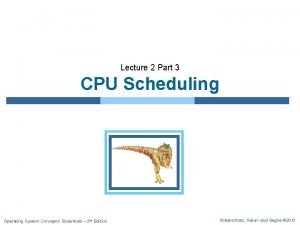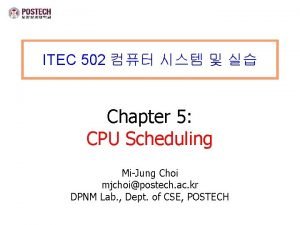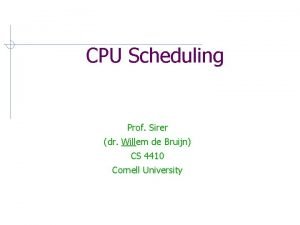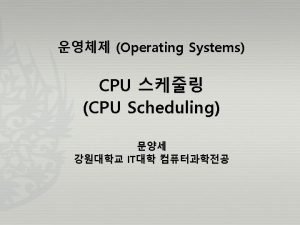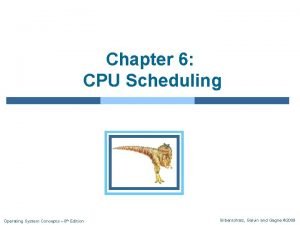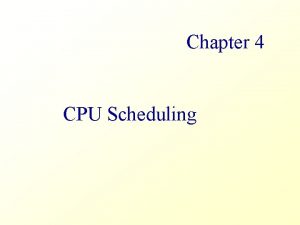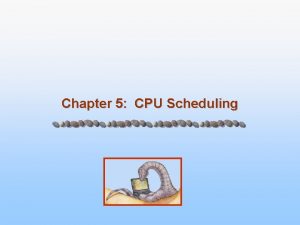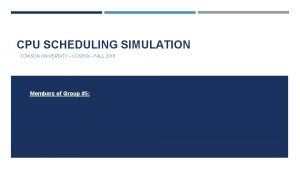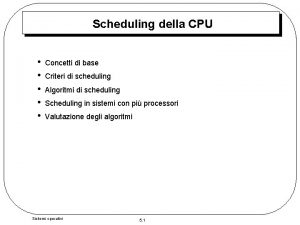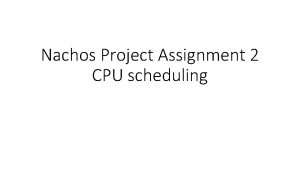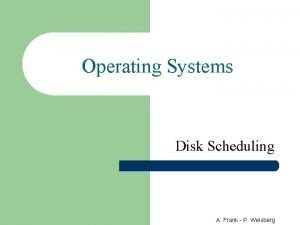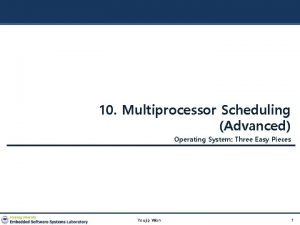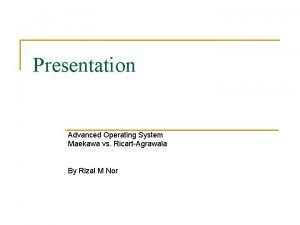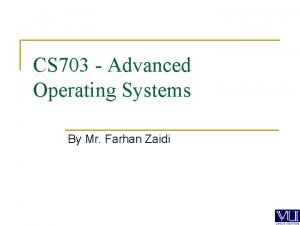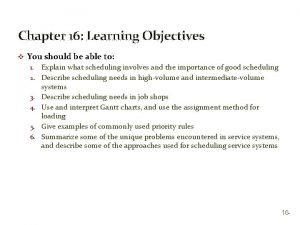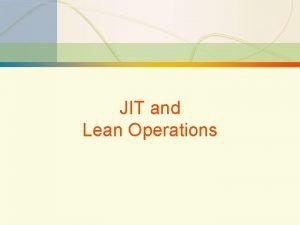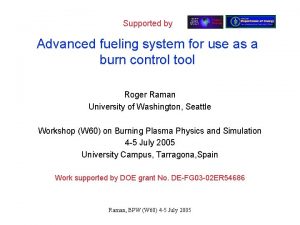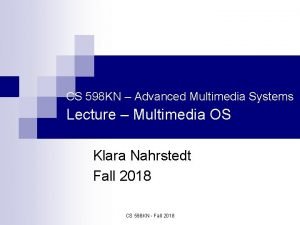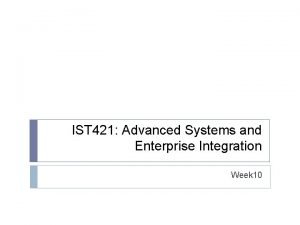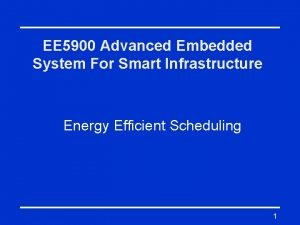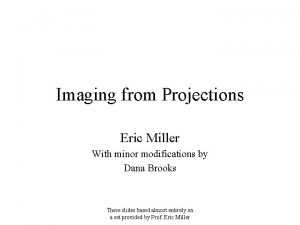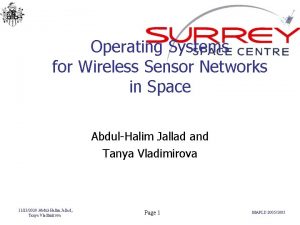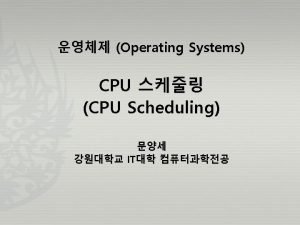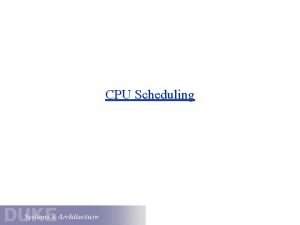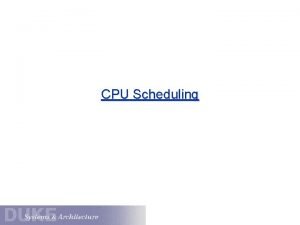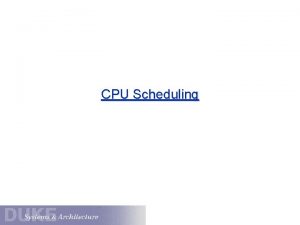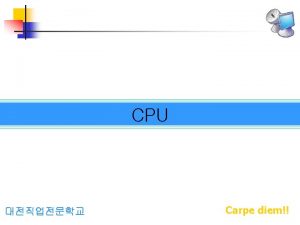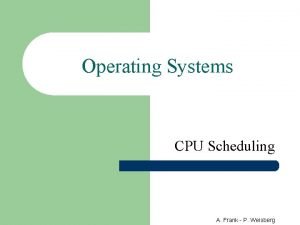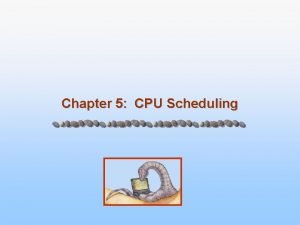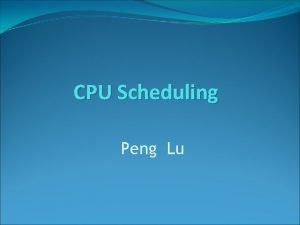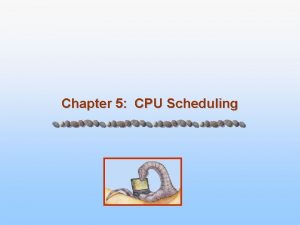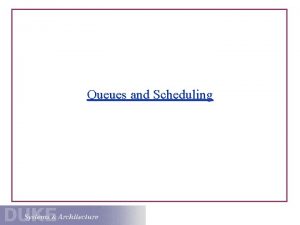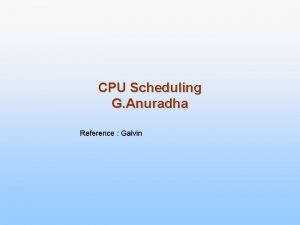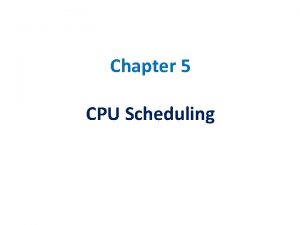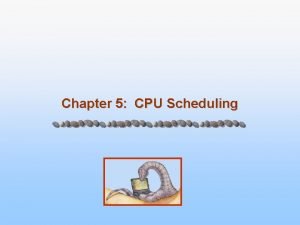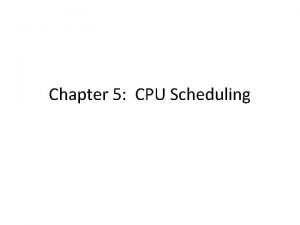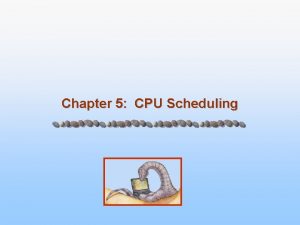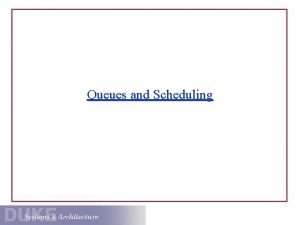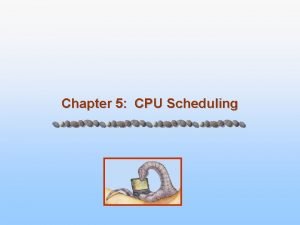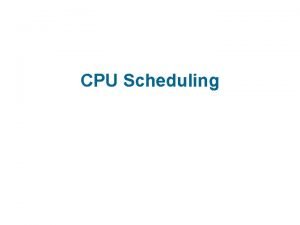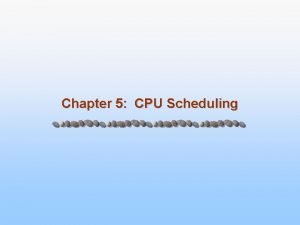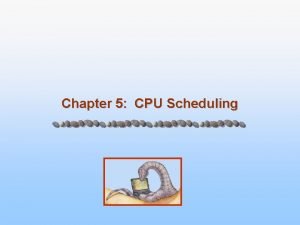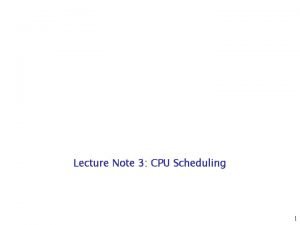Operating Systems Advanced CPU Scheduling A Frank P


































- Slides: 34

Operating Systems Advanced CPU Scheduling A. Frank - P. Weisberg

CPU Scheduling • • • 2 Basic Concepts Scheduling Criteria Simple Scheduling Algorithms Advanced Scheduling Algorithms Evaluation A. Frank - P. Weisberg

Idea of Time Quantum • Decision mode: preemptive – – a process is allowed to run until the set time slice period, called time quantum, is reached. – then a clock interrupt occurs and the running process is put on the ready queue. • How to set the quantum q? 3 A. Frank - P. Weisberg

Shortest-Remaining-Job-First (SRJF) • Associate with each process the length of its next/remaining CPU burst. Use these lengths to schedule the process with the shortest time. • Preemptive – if a new process arrives with CPU burst length less than remaining time of current executing process, preempt. • Called Shortest-Remaining-Job-First (SRJF). 4 A. Frank - P. Weisberg

Example of Shortest-remaining-time-first Process. Aarri Arrival Time. T P 1 0 P 2 1 P 3 2 P 4 3 Burst Time 8 4 9 5 • Preemptive SJF Gantt Chart • Average waiting time = [(10 -1)+(17 -2)+5 -3)]/4 = 26/4 = 6. 5 5

Another Example of SRJF Process Arrival Time Burst Time P 1 0. 0 7 P 2 2. 0 4 P 3 4. 0 1 P 4 5. 0 4 • SRJF (preemptive) with q = 2 P 1 0 P 2 2 P 3 4 P 2 5 P 4 7 P 1 11 16 • Average waiting time = (9 + 1 + 0 +2)/4 = 3 6 A. Frank - P. Weisberg

Round-Robin (RR) • Selection function: (initially) same as FCFS. • Decision mode: preemptive – – a process is allowed to run until the time slice period, called time quantum, is reached. – then a clock interrupt occurs and the running process is put at the end of the ready queue. 7 A. Frank - P. Weisberg

Round-Robin (RR) Example 8 Process Arrival Time Service Time 1 0 3 2 2 6 3 4 4 4 6 5 5 8 2 A. Frank - P. Weisberg

Example of RR with Time Quantum = 4 Process P 1 P 2 P 3 Burst Time 24 3 3 • The Gantt chart is: • Typically, higher average turnaround than SJF, but better response. 9

Another RR Example (q = 1) 10 A. Frank - P. Weisberg

Another RR Example (q = 4) 11 A. Frank - P. Weisberg

Example of RR with Time Quantum = 20 Process P 1 P 2 P 3 P 4 • The Gantt chart is: P 1 0 P 2 20 37 P 3 Burst Time 53 17 68 24 P 4 57 P 1 77 P 3 P 4 P 1 P 3 97 117 121 134 154 162 • q should be large compared to context switch time. • q usually 10 ms to 100 ms, context switch < 10 usec. 12 A. Frank - P. Weisberg

Dynamics of Round Robin (RR) • Each process gets a time quantum, usually 10 -100 milliseconds. After this time has elapsed, the process is preempted and added to the end of the ready queue. • If there are n processes in the ready queue and the time quantum is q, then each process gets 1/n of the CPU time in chunks of at most q time units at once. No process waits more than (n-1)q time units. • Performance 13 – q large FIFO. – q small q must be large with respect to context switch, otherwise overhead is too high. A. Frank - P. Weisberg

Time Quantum and Context Switch Time 14 A. Frank - P. Weisberg

Turnaround Time varies with the Time Quantum 15 A. Frank - P. Weisberg

Time Quantum for Round Robin • Must be substantially larger than the time required to handle the clock interrupt and dispatching. • Should be larger then the typical interaction (but not much more to avoid penalizing I/O bound processes). 16

Round Robin Drawbacks • Still favors CPU-bound processes: – A I/O bound process uses the CPU for a time that is less than the time quantum and then blocked waiting for I/O. – A CPU-bound process runs for all its time slice and is put back into the ready queue (thus getting in front of blocked processes). • A solution: virtual round robin: – When a I/O has completed, the blocked process is moved to an auxiliary queue which gets preference over the main ready queue. – A process dispatched from the auxiliary queue runs no longer than the basic time quantum minus the time spent running since it was selected from the ready queue. 17 A. Frank - P. Weisberg

Multiple Priorities • Implemented by having multiple ready queues to represent each level of priority. • Scheduler will always choose a process of higher priority over one of lower priority. • Lower-priority may suffer starvation. • Then allow a process to change its priority based on its age or execution history. • Our first scheduling algorithms did not make use of multiple priorities. • We will now present other algorithms that use dynamic multiple priority mechanisms. 18 A. Frank - P. Weisberg

Priority Scheduling with Queues 19 A. Frank - P. Weisberg

Priority Queuing 20 A. Frank - P. Weisberg

Multilevel Queue Scheduling (1) • Ready queue is partitioned into separate queues: - foreground (interactive) - background (batch) • Process permanently in a given queue. • Each queue has its own scheduling algorithm: - foreground – RR - background – FCFS • Scheduling must be done between the queues: – Fixed priority scheduling (i. e. , serve all from foreground then from background) – possibility of starvation. – Time slice – each queue gets a certain amount of CPU time which it can schedule amongst its processes; i. e. , 80% to foreground in RR; 20% to background in FCFS. 21 A. Frank - P. Weisberg

Multilevel Queue Scheduling (2) 22 A. Frank - P. Weisberg

Multilevel Feedback Queue • Preemptive scheduling with dynamic priorities. • A process can move between the various queues; aging can be implemented this way. • Multilevel-feedback-queue scheduler defined by the following parameters: 23 – number of queues. – scheduling algorithms for each queue. – method used to determine which queue a process will enter when that process needs service. – method used to determine when to upgrade process. – method used to determine when to demote process. A. Frank - P. Weisberg

Multiple Feedback Queues 24 A. Frank - P. Weisberg

Dynamics of Multilevel Feedback • Several ready to execute queues with decreasing priorities: – P(RQ 0) > P(RQ 1) >. . . > P(RQn). • New process are placed in RQ 0. • When they reach the time quantum, they are placed in RQ 1. If they reach it again, they are place in RQ 2. . . until they reach RQn. • I/O-bound processes will tend to stay in higher priority queues. CPU-bound jobs will drift downward. • Dispatcher chooses a process for execution in RQi only if RQi-1 to RQ 0 are empty. • Hence long jobs may starve. 25 A. Frank - P. Weisberg

Example of Multilevel Feedback Queue • Three queues: – Q 0 – RR with time quantum 8 milliseconds – Q 1 – RR with time quantum 16 milliseconds – Q 2 – FCFS • Scheduling: – A new job enters queue Q 0 which is served FCFS. When it gets CPU, job receives 8 milliseconds. If it does not finish in 8 milliseconds, job is moved to queue Q 1. – At Q 1 job is again served FCFS and receives 16 additional milliseconds. If it still does not complete, it is preempted and moved to queue Q 2. – Could be also vice versa. 26 A. Frank - P. Weisberg

Multilevel Feedback Queues 27 A. Frank - P. Weisberg

Time Quantum for Feedback Scheduling • With a fixed quantum time, the turnaround time of longer processes can stretch out alarmingly. • To compensate we can increase the time quantum according to the depth of the queue: – Example: time quantum of RQi = 2^{i-1} • See next slide for an example. • Longer processes may still suffer starvation. Possible fix: promote a process to higher priority after some time. 28 A. Frank - P. Weisberg

Time Quantum for Feedback Scheduling 29 A. Frank - P. Weisberg

Algorithms Comparison • Which one is best? • The answer depends on: – on the system workload (extremely variable). – hardware support for the dispatcher. – relative weighting of performance criteria (response time, CPU utilization, throughput. . . ). – The evaluation method used (each has its limitations. . . ). 30 • Hence the answer depends on too many factors to give any. . . A. Frank - P. Weisberg

Scheduling Algorithm Evaluation • Deterministic modeling – takes a particular predetermined workload and defines the performance of each algorithm for that workload. • Queuing models • Simulations • Implementation 31 A. Frank - P. Weisberg

Evaluation of CPU Schedulers by Simulation 32 A. Frank - P. Weisberg

Thread Scheduling 33 • Depends if ULT or KLT or mixed. • Local Scheduling – How the threads library decides which ready thread to run. • ULT can employ an application-specific thread scheduler. • Global Scheduling – How the kernel decides which kernel thread to run next. • KLT can employ priorities within thread scheduler. A. Frank - P. Weisberg

Thread Scheduling Example 34 A. Frank - P. Weisberg
 Turnaround time in os
Turnaround time in os Preemptive sjf
Preemptive sjf Sjf cpu scheduling
Sjf cpu scheduling First come first serve calculator
First come first serve calculator Cpu i/o
Cpu i/o Sjf cpu scheduling
Sjf cpu scheduling Scheduling concept in os
Scheduling concept in os A cpu scheduling algorithm determines an order
A cpu scheduling algorithm determines an order Cpu scheduling project
Cpu scheduling project Scheduling della cpu
Scheduling della cpu Cpu scheduling project
Cpu scheduling project Job scheduling vs process scheduling
Job scheduling vs process scheduling Computer architecture
Computer architecture Disk scheduling in operating system
Disk scheduling in operating system Multiprocessor scheduling in os
Multiprocessor scheduling in os Frank william abagnale jr. young
Frank william abagnale jr. young Operating system lecture notes
Operating system lecture notes Advanced operating system
Advanced operating system Advanced operating system
Advanced operating system Scheduling ahead from a point in time.
Scheduling ahead from a point in time. Scheduling in low-volume systems is known by what term?
Scheduling in low-volume systems is known by what term? Nnemp
Nnemp Advanced fueling systems
Advanced fueling systems Advanced multimedia systems
Advanced multimedia systems Advanced fluid systems
Advanced fluid systems Tom kilcer advanced ag systems
Tom kilcer advanced ag systems Ist 421
Ist 421 Advanced embedded systems
Advanced embedded systems Enotes fst
Enotes fst Advanced cooling systems inc
Advanced cooling systems inc The example of operating system
The example of operating system Evolution of operating systems
Evolution of operating systems Components of an operating system
Components of an operating system Components of os
Components of os Wsn operating systems
Wsn operating systems
